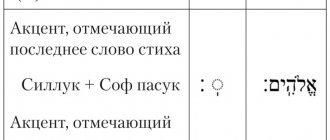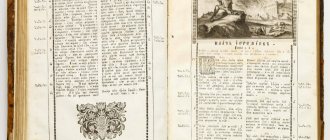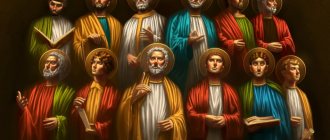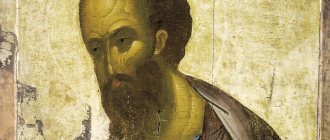| Source: | |||||||||||
Illuminated page of the book of the prophet Isaiah from a handwritten Bible (presumably 12th century). Jewish Encyclopedia (1901–1912). A page from a 13th century handwritten Bible. with a micrographic masora arranged in the form of an ornament. Jewish Encyclopedia (1901–1912).
TANAKH (תַּנַ»ךְ) - the name of the Hebrew Bible (in the Christian tradition - the Old Testament), which came into use in the Middle Ages and is accepted in modern Hebrew. The word is an acronym (initial letters) of the names of three sections of Holy Scripture:
The term “TaNaKh” first appeared in the writings of medieval Jewish theologians.[1] The dating of the earliest texts ranges from the 12th to the 8th centuries. BC e., the latest books date back to the 2nd–1st centuries. BC e.[2] |
Title of Scripture
The Jewish Holy Scripture does not have a single name that would be common to the entire Jewish people and used in all periods of its history. The earliest and most common term is הַסְּפָרִים, ha-sfarim (`books`). The Jews of the Hellenistic world used the same name in Greek - hτα βιβλια - Bible, and it entered mainly through its Latin form into European languages.
The term סִפְרֵי הַקֹּדֶשׁ sifrei ha-kodesh (“holy books”), although found only in Jewish medieval literature, apparently was sometimes used by Jews already in the pre-Christian period. However, this name is rare, since in rabbinic literature the word “sefer” (“book”) was used, with few exceptions, only to designate biblical books, which made it unnecessary to attach any definitions to it.
In the Mishnah and other sources of the Mishnaic period, the name “כִּתְבֵי הַקֹּדֶשׁ” kitvei ha-kodesh
(`Holy Scripture`). The use of the Hebrew root כתב (to write) to designate biblical literature has a special meaning. It emphasizes that we are talking about written form - as opposed to oral, in which the teachings of the sages and rabbis were transmitted before the composition of the Mishnah.
Likewise, the word "מִקְרָא" is mikra
(`reading'), which at the same period also began to come into use to refer to the Bible, indicates that it was studied by reading aloud. It also testifies to public reading, which played an important role in the Jewish synagogue liturgy. This term was especially widespread among Jews in the Middle Ages. Subsequently, the acronym “Tanakh” (תַּנַ»ךְ) also began to be used, consisting of the first letters of the names of three sections of the Bible: Torah (Pentateuch), Neviim (Prophets) and Ketuvim (Writings).
The word Torah, being the common name for the first section of the Bible, has a broader meaning of Divine revelation, law and Jewish religious teaching in general; it is sometimes used in rabbinic literature to refer to the Bible as a whole.
The Old Testament is a purely Christian name for the Bible. It is used to terminologically separate the Hebrew Bible from the Christian New Testament.
The term “canon” as applied to the Bible clearly indicates the closed, unchangeable nature of the final edition of the Holy Scriptures, considered as the result of Divine revelation. For the first time, the Greek word “canon” was used in relation to the sacred books by the first Christian theologians, the so-called church fathers in the 4th century. n. e.
There is no exact equivalent for this term in Jewish sources, but the concept of "canon" in relation to the Bible is clearly Jewish. The Jews became the “people of the Book,” and the Bible became the key to their life. The commandments of the Bible, teaching and worldview were imprinted in the thinking and in all the spiritual creativity of the Jewish people. Canonized Scripture was unconditionally accepted as the true testimony of the national past, the personification of the reality of hopes and dreams.
Over time, the Bible became the main source of knowledge of Hebrew and the standard of literary creativity. The Oral Law, based on the interpretation of the Bible, revealed the full depth and power of the truths hidden in the Bible, embodied and put into practice the wisdom of the law and purity of morality. In the Bible, for the first time in history, the spiritual creativity of the people was canonized, and this turned out to be a revolutionary step in the history of religion. Canonization was consciously accepted by Christianity and Islam.
Of course, the books included in the Bible could by no means reflect the entire literary heritage of Israel. There is evidence in Scripture itself of a vast literature that has since been lost; for example, the “Book of the Wars of the Lord” (Num. 21:14) and the “Book of the Righteous One” (“Sefer ha-yashar”; Ibn. 10:13; II Sam. 1:18) mentioned in the Bible are undoubtedly very ancient. True, in a number of cases the same work may have been mentioned under different names, and the word sefer could designate only a section of the book, and not the book as a whole. There is reason to believe that there were numerous other works that the Bible does not mention.
The very concept of creating a canon of Scripture involves a long process of selecting the works on which it is based. Holiness was a necessary condition for the canonization of a particular book, although not everything that was considered sacred and the fruit of Divine revelation was canonized. Some works have survived only due to their literary merits. A very important role was probably played by the schools of scribes and clergy who, with their inherent conservatism, sought to transmit from generation to generation the main texts they studied. Then the very fact of canonization forced one to honor the book included in the canon and contributed to the perpetuation of reverence for the Holy Scriptures.
There is an apocryphal analogue of the Torah - the Book of Jubilees
Although the boom of apocryphal books occurred in the New Testament era, and they were written in Jewish times. The Torah, or rather the Book of Genesis, also has a double. Its earliest text is from the 2nd century BC. It's called the Book of Jubilees. How does this apocrypha differ from the Book of Genesis?
The story is told from the perspective of an angel.
The Book of Jubilees tells in detail about the rites and rituals of the Jews.
New parts available. For example, Adam and Eve have daughters - Avan and Azura.
Noah's Ark lands on Mount Lubar.
The Bible has a special attitude towards Jews. The Holy Scriptures call them the people of God. And the text of the Book of Books itself was written in the bosom of this culture. Prophets, patriarchs, great kings, apostles, even Jesus Christ himself all belong to the Jewish race. The most important shrines are located in Israel. And that is why it is surprising that Christianity, which has swept the whole world, is so unpopular in its homeland.
Why don't Jews believe in Christianity? Are there any exceptions among them? How do Jewish Christians who recognize the New Testament live today?
Composition of TaNaKha
The TaNakh includes 39 books.
Main article
:
Books of the Tanakh
In Talmudic times, it was believed that the Tanakh contains 24 books. This number is obtained if we combine the books of Ezra (book) of Ezra and Nehemiah, consider the entire collection of Trey Asar as one book, and also count both parts of the books of Shemuel, Melachim and Divrei Ha-Yamim as one book.
In addition, sometimes pairs of books Shoftim and Ruth, Irmeyahu and Eikha are conditionally combined, so that the total number of books of TaNaKh is equal to 22 according to the number of letters of the Hebrew alphabet.
The Babylonian Talmud[6] indicates the order of the books of the TaNaKh, which is different from the one now accepted. In this source, the book of Yeshayahu comes after Yechezkel and before Trey Asar. The Scriptures are arranged in the following order: Ruth, Tehillim, Job, Mishlei, Kohelet, Shir Hashirim, Eicha, Daniel, Esther, Ezra (united with Nehemiah), Divrei HaYamim.
Various ancient manuscripts of the TaNaKh also give different orders of the books in it. The order of the books of the TaNaKh, accepted in the Jewish world, corresponds to the edition of Mikraot Gedolot
[7].
Catholic and Orthodox canons of the Old Testament
include additional books that are not in the TaNakh - apocrypha and pseudepigrapha.
The division of the TaNakh into three parts is attested by many ancient authors. We find mention of “the law, the prophets and the rest of the books” (Sir. 1:2) in the book of Ben Sira (The Wisdom of Jesus, son of Sirach), written around 190 BC. Three sections of the TaNakh are also mentioned by Philo of Alexandria (c. 20 BC - c. 50 AD) and Josephus (37 AD - ?). In the Gospels the wording is found: “ in the Law of Moses, in the Prophets and Psalms
"(Luke 24:44).
Compilers of the books of TaNaKha
Based on: Babylonian Talmud, treatise Bava Batra, 14B-15A
| Hebrew name | Compiled by |
| Torah | Moshe (Moses) |
| Torah (last 8 phrases) | Joshua bin Nun (Joshua) |
| Yeshua | Yeshua bin Nun |
| Shoftim | Shemuel (Samuel) |
| Shmuel | Shemuel. Some fragments are the prophets Gad and Nathan |
| Melachim | Irmeyahu (Jeremiah) |
| Yeshayahu | Hezekiah (Hezekiah) and his retinue |
| Yermiyaw | Irmeyahu |
| Yehezkel | Men of the great assembly: Hagai, Zechariah, Malachi, Zerubabel, Mordechai, etc. |
| Twelve Minor Prophets | Men of the Great Assembly |
| Tehillim | David and the ten wise men: Adam, Malkitzedek, Abraham, Moshe, Heman, Jedutun, Asaph and the three sons of Korach. According to another version, Asaph was one of the sons of Korach, and the tenth was Solomon (Solomon). According to the third version, one of the compilers was not Abraham, but Eitan. |
| Mishley | Hezkiyah and his retinue |
| Job | Moshe |
| Song of Songs | Hezkiyah and his retinue |
| Ruth | Shemuel |
| Eiha | Irmeyahu |
| Kohelet | Hezkiyah and his retinue |
| Esther | Men of the Great Assembly |
| Daniel | Men of the Great Assembly |
| Ezra | Ezra |
| Nehemia | Nehemia |
| Divrei Hayamim | Ezra, Nehemiah |
Crossing the Red Sea
After this event, the Jews left Egypt. Apparently there were at least 600 thousand men, and apparently at least one and a half million in total. Pharaoh chased after the Jews, but the Lord helped his people and the waters of the sea parted, allowing Moses and His people to pass, but when the people of Israel passed, the waters closed again and led to the death of Pharaoh’s army, which was following on the heels of the Jews.
… And the Lord delivered Israel that day from the hand of the Egyptians, and the [sons of] Israel saw the Egyptians dead on the seashore. (Exodus chapter 14)
After crossing the Red Sea, the Israelites believed even more in the Lord and in his prophet Moses. They sang a song of praise to the Lord - Exodus chapter 15.
Chapter and verse numbers, division of books
The modern division of books into chapters was introduced by Bishop of Canterbury Stephen Langton in 1214 for the Vulgate text. The text of the Tanakh was first divided into chapters by Isaac Nathan ben Kalonymus in the 15th century. when composing the first Hebrew concordance, Meir Nativ. The Vulgate verses are numbered by Santes Panino in the first half of the 16th century, then by Robert Etienne c. 1555 Subsequently this division was almost mechanically transferred to the Hebrew Bible.
The division into chapters and verse numbers has no meaning in Jewish tradition. However, they are present in all modern editions of the TaNaKh, which makes it easier to find and quote verses. The division of the books of Shemuel, Melachim and Divrei HaYamim into parts I and II is done only for the convenience of handling large books. Jewish acceptance of the Christian chapter division began in late medieval Spain, partly in the context of forced religious debates that took place against the backdrop of severe persecution and the Spanish Inquisition. The purpose of adopting this division was to facilitate the search for biblical quotations. To this day, in the traditional yeshiva world, chapters of the books of Tanakh are called ne perek
, as chapters of the Mishnah or midrash, and the borrowed word is
capital
.
From the point of view of Jewish tradition, the division into chapters is not only unjustified, but is also open to serious criticism of three types:
- The chapter divisions sometimes reflect the Christian interpretation of the Bible.
- Even if they are not intended to be a Christian interpretation, the chapters often divide biblical texts in many places that may be considered inappropriate for literary or other reasons.
- They ignore the accepted division between closed and open spaces found in the Masoretic texts.
Chapter and verse numbers were very often listed prominently in older editions, in addition to obscuring the traditional Jewish Masoretic divisions. However, in many Jewish editions of the TaNakh published over the last forty years, there has been a tendency to minimize the impact and significance of chapter and verse numbers on the page. Most publications have achieved this by removing them from the text itself and moving them to the edges of the pages. The main text in these editions is not interrupted at the beginning of chapters (which are noted only in the margins). The lack of chapter breaks in the text in these editions also serves to reinforce the visual impact created by the spaces and paragraph starts on the pages that refer to traditional Jewish divisions.
These modern Jewish editions present the books of Shemuel, Melachim, and Divrei HaYamim as one book on their title pages, and make no indication within the main text of their division into two parts (although this is noted in the top and side margins). In such editions, the second books of Shemuel, Melachim and Divrei HaYamim are continuations of the first books on the same pages where the first ones end, without any breaks in the text. In the case of the book Melachim, which does not have a traditional division at a given point in the text, the text of the second part of the book begins on the same line where the text of the first part ends.
Content
- 1 Contents of the Tanakh
- 2 Composition of Tanakh 2.1 Torah (Pentateuch)
- 2.2 Nevi'im (Prophets)
- 2.3 Ketuvim (Scriptures)
- 2.4 Traditional compilers of the books of Tanakh
- 3.1 Masoretic text
- 5.1 Methods of interpretation
- 7.1 Transfers
Editions
- The first printed Chumash in Hebrew was simply a biblical text with Rashi on the cover, and many other editions have appeared since then.
- The first Masoretic Mikraot Gdolot was printed in Venice in 1524-1525, edited by Daniel Bomberg.
- Soncino's edition was printed in 1527 in Venice.
- Many editions of Mikraot Gdolot have been released since then.
- Rudolf Kittel's Biblia Hebraica appeared in 1906 and was reprinted in 1913.
- The Leningrad Codex was edited under Pavel E. Kale as the Biblia Hebraica (BHK), published in Stuttgart, in 1937. The codex was also used for the Biblia Hebraica Stuttgartensia (BHS) in 1977, and will be used for the Biblia Hebraica Quinta (BHQ). The Leningrad Codex presents a different order for the books of Ketuvim.
- Mesorah Publications מקראות גדלות, (Jerusalem, 1996)
- The JPS Hebrew-English Tanakh (Philadelphia, 1999)
- Aleppo Codex edited by Mordecai Breuer 1977-1982
- The Crown of Jerusalem: The Bible of the Hebrew University of Jerusalem, 2000. Edited according to the method of Mordechai Breuer under the direction of Yosef Ofer, with additional corrections and clarifications compared to the Horev edition.
- Jerusalem Simanim Institute, Feldheim Publishers, 2004 (published in one-volume and three-volume editions).
In the Middle Ages, Europeans forced Jews to convert to Christianity.
But not all Jews are Jews. There are those who profess Christianity. There are few of them, since the Torah forbids Jews to follow other people's customs, and this prohibition is firmly rooted in Jewish culture.
Marranos are Jews who, under duress, were forced to be baptized and profess Christianity
However, since the Middle Ages, Jews have adopted Christianity en masse. This was not a voluntary initiative. They took this step under pressure. For example, in 1492 in Spain, the authorities created an edict on the expulsion of Jews. This is how the Marranos appeared.
The Marranos were Jews who, under duress and threat of expulsion from Spain and Portugal, were forced to be baptized and profess Christianity. But this cannot be called a sincere act.
The Marranos often remained loyal to the Jewish tradition and practiced it secretly.
In fact, even sincere acceptance of Christianity did not save the Marranos from persecution by the Inquisition. They remained in an oppressed position for a long time.
Secret meeting of the Marranos during the Inquisition. Painting of Moses Maimon
Notes and sources
- Eg. Tosfot RiD on Taanit 4a.
- See eg. Bible, TSB, Old Testament (Encyclopedia Britannica)
- https://www.istok.ru/jews-n-world/Forta/Forta_13.shtml
- Article " Quran
" in the Electronic Jewish Encyclopedia - Article “ Bible.
The influence of the Bible on world and Jewish culture " in the Electronic Jewish Encyclopedia - Bava Batra 14b
- Emanuel Tov
Textology of the Old Testament. - Moscow: BBI, 2001. - P. 3-4.
Sources
- KEE, volume 1 + Add. 2, count. 399 + 195–197
- KEE, volume 1, col. 401–411
- KEE, volume 8, col. 746
- TaNakh in Hebrew in pdf format.
- Hebrew Bible - TaNakh.
- Text of the TaNaKh translated by D. Josephon. ed. "Mossad Rav Kook"
- TaNakh with parallel text in Russian and Hebrew
- Text of TaNaKha with a set of comments
- TaNakh in Russian and English with text search capabilities
- Text of the TaNaKha (Hebrew)
- Russian Bible Society: Old Testament: new translation from Hebrew
- Interlinear translation of the Septuagint books into Russian
- Interlinear translation of the Septuagint books into English (utf-8)(English)
- Bible for a mobile device with Strong's numbers, parallel passages, modern and synodal translations, Barkley's commentaries, the ability to leave comments on the Internet and equipped with a convenient navigation system
- Collection of references to various canonical texts and apocrypha
- Biblical scenes on ancient postcards on the website of the Odessa Museum of Numismatics
- History of the Synodal Bible Translation
Notice
: The preliminary basis of this article was the article Tanakh in the EEE
Notice
: The preliminary basis of this article was the article Bible in the EEE
Notice
: The preliminary basis of this article was the article Bible. History of creation and characteristics of individual books of the Bible in the EEE
Literature
Translations
- Septuagint (Translation of the Seventy Interpreters), III-I centuries BC. e., into ancient Greek.
- Targum of Onkelos, end of the 1st century AD. e., into Western Aramaic.
- Peshitta, before the 5th century AD e., most likely in the 3rd century AD. BC [31], into Eastern Aramaic (Syriac).
- Old Latin translations, before the 4th century AD. e., in Latin.
- Vulgate, IV-V century AD. e., in Latin.
- Coptic version of the Bible, IV-V century AD. e., into various dialects of the Coptic language.
- Tafsir, 10th century AD, in Arabic.
Into Church Slavonic
- As part of the Gennadian Bible, completed by 1499[32], from the Septuagint and Vulgate.
- As part of the Francis Skaryna Bible, 1517-1519[33], from the Czech translation of the Bible (Czech)Russian..
- As part of the Ostrog Bible, 1581[34], from various sources.
- As part of the Elizabethan Bible, 1751[35], according to the Ostrog Bible, with reconciliation with the Septuagint, Vulgate and other sources.
To Russian
- Archimandrite Macarius, 1860-1867[36].
- Groups of translators led by David Yosifon[37], Mossad Rav Kook publishing house, 1975[38]; was republished in 1978[39].
- Mikhail Kovsan, 2012-2016[40].
Dictionaries
- Brown F., Driver SR, Briggs CA A Hebrew and English Lexicon of the Old Testament. Oxford, 1907.
- Koehler L., Baumgartner W. The Hebrew and Aramaic Lexicon of the Old Testament / Revised by W. Baumgartner and J. Stamm. Leiden, 1994—2000.
- Grafov A.E. Dictionary of Biblical Hebrew. - M.: Text, 2021. - 702 p. — ISBN 978-5-7516-1537-6.










